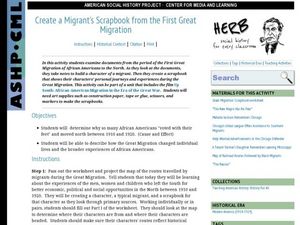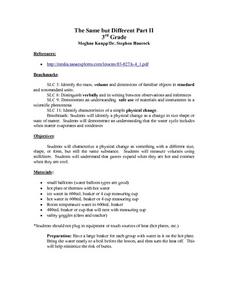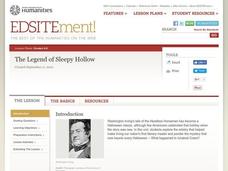Curated OER
The First Part Last: Part 3
For this The First Part Last comprehension check worksheet, young scholars respond to 20 short answer questions pertaining to part 3 of the Angela Johnson novel to better understand the novel and the author's craft.
Curated OER
The First Part Last: Part 2
In this The First Part Last comprehension check worksheet, students respond to 20 short answer questions pertaining to part 2 of the Angela Johnson novel to better understand the novel and the author's craft.
Curated OER
Character Traits
Using a three-column chart labeled "Character," "Action," and "Trait," pupils analyze the traits of several characters from a short story. The lesson is designed for a SMART board, but a teacher could easily do the lesson without the...
Curated OER
Create a Migrant's Scrapbook from the First Great Migration
Help young historians personally engage in the stories of African Americans during the Great Migration! Assessing a migration route map, learners create a migrant character's experience, adding details while studying primary sources. A...
Curated OER
Lesson Plan 2: So What's a Novel, Anyway?
What makes a novel a novel? Class members select a favorite novel, record their impressions on a worksheet, and then come together in groups to discuss the elements common to narrative writing. Next, they identify the characters, the...
Curated OER
Lesson Plan 2: Good Novel, Bad Novel
What are the characteristics of a good piece of writing? What makes a story interesting? Give your pupils a chance to define the qualities of good novels and what they see as the qualities of bad novels. Class members record these...
Curated OER
To Kill A Mockingbird: Characterization
Students analyze several of the characters from "To Kill a Mockingbird". They view segments of the film, create character webs based on the most revealing film scenes, write journal entries and participate in class discussion.
Mathematics Assessment Project
Solving Linear Equations in One Variable
A thorough and professional appearance characterizes a activity on linear equations. Maturing mathematicians are taught to identify and exemplify linear equations with a single variable. They also classify equations according to the...
Pace University
Grade 6-8 Living Things
What characterizes a living thing? Scholars explore the concept during a differentiated instruction unit on living things. They perform lab experiments to determine how animals adapt to stimuli, watch videos and learn about...
Curated OER
William Faulkner's The Sound and the Fury: Narrating the Compson Family Decline and the Changing South
Learners analyze the novel, "The Sound and the Fury," written by iam Faulkner, tracing the changing South. Through the narrative structure, the point of view, and the relationship between change and characterization, students view the...
Curated OER
Characters in Live Performance
Your intermediate or advanced thespians choose dramatic scenes to perform in duos, small groups, or solo to demonstrate vocal and physical characterization. Use class time to prepare and rehearse. Detailed rubrics work for peer assessment.
Curated OER
Information Problem Solving
Middle schoolers locate the specific elements of text and illustrations that communicate setting, characterization, and plot in order to evaluate how the text and illustrations work together to communicate effectively.
Curated OER
Review and Quiz on Punctuation CS
Explore indirect and direct characterization and review rules of punctuation. After a review, middle schoolers complete a short worksheet, labeling sentences as an example of a direct or indirect characterization. In groups, they play a...
Curated OER
Theater: Create a Script
Figurative language is the focus in the book Teach Us, Amelia Bedelia. After reading Peggy Parish's book, class members dramatize idioms from the text, using dramatic strategies such as characterization, exaggeration, and improvisation....
National Endowment for the Humanities
Jacob Lawrence's Migration Series: Removing the Mask
Describe, analyze, compare and contrast poets from the Harlem Renaissance. Critical thinkers analyze the imagery, characterization, tone, symbolism, and historical context of Jacob Lawrence, Helene Johnson, and Paul Laurence Dunbar. A...
Curated OER
Symmetries of a Quadrilateral I
Learners examine the properties of quadrilaterals from the point of view of rigid motion. Different types of quadrilaterals are characterized by their symmetries, so learners explore the symmetries of a described quadrilateral to...
Curated OER
Exploring our National Parks
Students utilize maps/Atlases to find key spatial information, locate U.S. National Parks, characterize the geography of a specific region, and create a National Park brochure.
Curated OER
Determining Importance
Students hone their skills at identifying the principle story in a work of art and text. Through discussion, students assess the central and supporting stories of a work of art that is characterized by multiple layers of action and meaning.
Curated OER
The Same, But Different Part II
Learners characterize a physical change as something that changes to a different size, but retains its basic substance. They measure volumes using milliliters, and perform an experiment that proves that gases expand when hot and contract...
Curated OER
The Legend of Sleepy Hollow
Explore Washington Irving's "The Legend of Sleepy Hollow" in this literature analysis lesson. Middle schoolers read and summarize the plot of the story. They then adapt passages for a contemporary audience and analyze the...
Curated OER
During Reading Strategy for Charles Dickens’ Great Expectations
Readers create a literary scrapbook for one of the characters in Charles Dickens' Great Expectations and fill it with mementoes, journal entries, letters, etc. A great way to get kids to think about characterization.
PBS
Supernatural Shakespeare and Macbeth
"A drum, a drum! Macbeth doth come." The withered and wild witches of Shakespeare’s Scottish play launch an examination of the fantastical elements in Act I, scene iii, paying particular attention to the action, imagery,...
ReadWriteThink
A Picture's Worth a Thousand Words: From Image to Detailed Narrative
A picture's worth a thousand words—and even more inspiration! A visual activity uses photographs to inspire writers. The process teaches aspects of narrative writing, such as point of view and characterization.
Concordia College Archives
History and Musical Aesthetics
What are the musical elements that characterize a school's fight song or its alma mater? Class members listen to examples of fight songs and alma maters from various schools, play a listening game, and then create a list of the...
Other popular searches
- Indirect Characterization
- Adjectives Characterization
- Teaching Characterization
- Characterization Worksheets
- Chaucer's Characterization
- Characterization Power Point
- Direct Characterization
- Analyze Characterization
- Characterization Literature
- Characterization Test
- Characterization in Fiction
- Characterization Methods

























